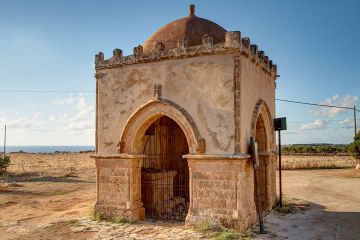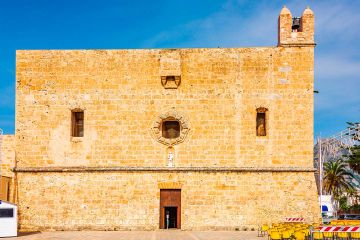
The legend tells of a young Roman patrician, the son of a high official of ancient Rome, named Vito. The years of persecution against the Christians of Diocletian ran and to escape the wrath of his father Ila and the prefect Valeriano and save himself from the assured end, he decided to flee his hometown, Mazzara, together with his nurse Crescenzia and his tutor Modesto, who they had converted to Christianity.
They began to sail north and after a few days they were hit by a bad storm, which forced them to land in a gulf well protected from the wind, on the coast of the feud of Punta by the ancients called Capo Egitarso (or Egitallo) well known by sailors of the time.
Here the three began to spread the word of God, trying to convert the inhabitants of the village of Conturrana, which stood about three kilometers from the sea, under a high rock.
In the name of God he healed the sick and chased away unclean spirits, but Vito, Modesto and Crescenzia were not able to convert the villagers to their faith, on the contrary, they were threatened and expelled by them. It was then that a giant landslide arrived, that buried the whole village and its inhabitants, as if it were divine punishment.
Crescenzia, taken from the senses of blows, turned around during their escape and it was thus that she was petrified to see the city being buried. The chapel dedicated to Santa Crescenzia, built by the Ericini family around 1400, was built precisely where she was petrified.

Arriving by car in San Vito Lo Capo you can easily see a large landslide area attributable to those events. It is called Contrada Valanga.
The passage of Vito and Crescenzia gave great emotions among the people of the area, and around 300 BC they dedicated a chapel to San Vito Martire, after he died in 299 when he was only 22 years old.
Over the centuries the chapel was enlarged and embellished to honor the saint. In addition, more and more pilgrims came to venerate the Holy Martyr, to give accommodation and hospitality to the faithful a sanctuary was built at the end of the 1400s to defend them from bandits and pirates.
After 150 years it became a full-fledged fortress and had elegant lodgings for the nobles and modest rooms for the poor people, stables and even a well known as "di Santo Vito".

The fame of the church and the miracles credited to S. Vito Martire and Santa Crescenzia attracted more and more people around the sanctuary and the "divine" punishments such as storms and avalanches that hit the corsairs who had plundered the church and robbed the faithful, they did nothing but contribute to the influx of people around the sanctuary, so, at the beginning of the 1700s, the first houses were built close to the building.
It is likely that these were only huts for the faithful in transit, then some families decided to stop, perhaps to offer food and accommodation to the pilgrims. At the end of the eighteenth century around the church there was already a small nucleus of houses.
Thus was born the town of San Vito lo Capo, but many decades still passed before it became an inhabited nucleus in the true sense of the word together with the surrounding districts.
The history of San Vito Santo is truly fascinating and it is nice to see how the legends of the place can have such deep roots and full of truth.
If you are curious to visit this beautiful country, you can book an accommodation and live and savor the history of S Vito.
We are waiting for you!
I TRE GOLFI is pleased to provide tourist information and assist ON-SITE users in planning their vacation in San Vito lo Capo and western Sicily.
Check-in / Check-out
+39 392 2338204

